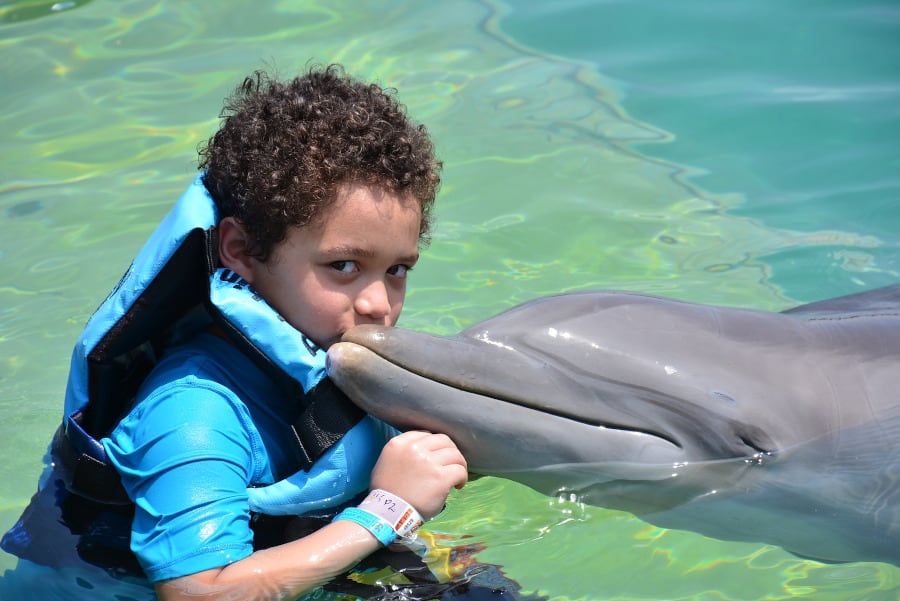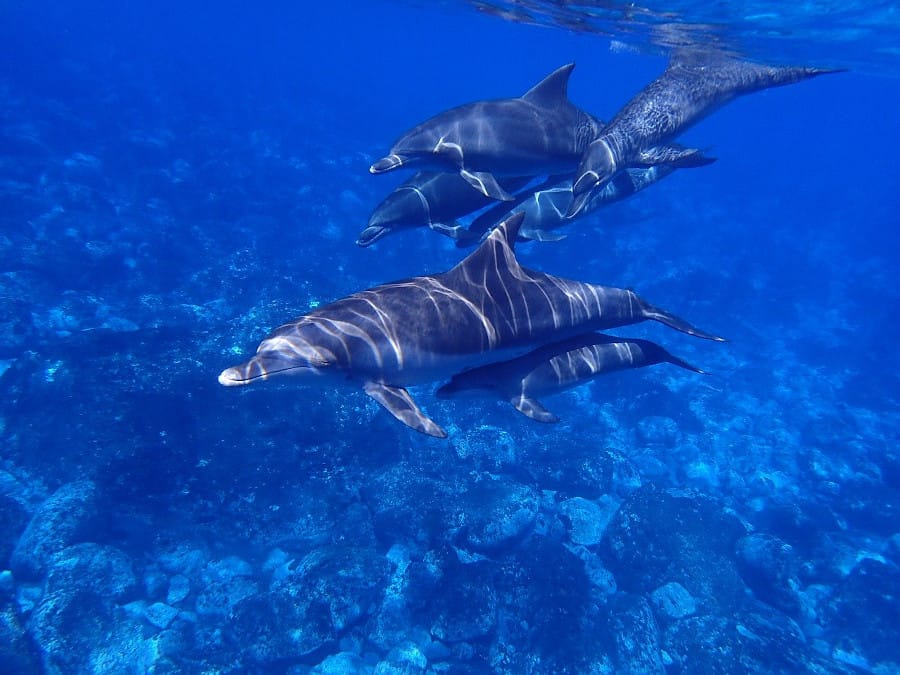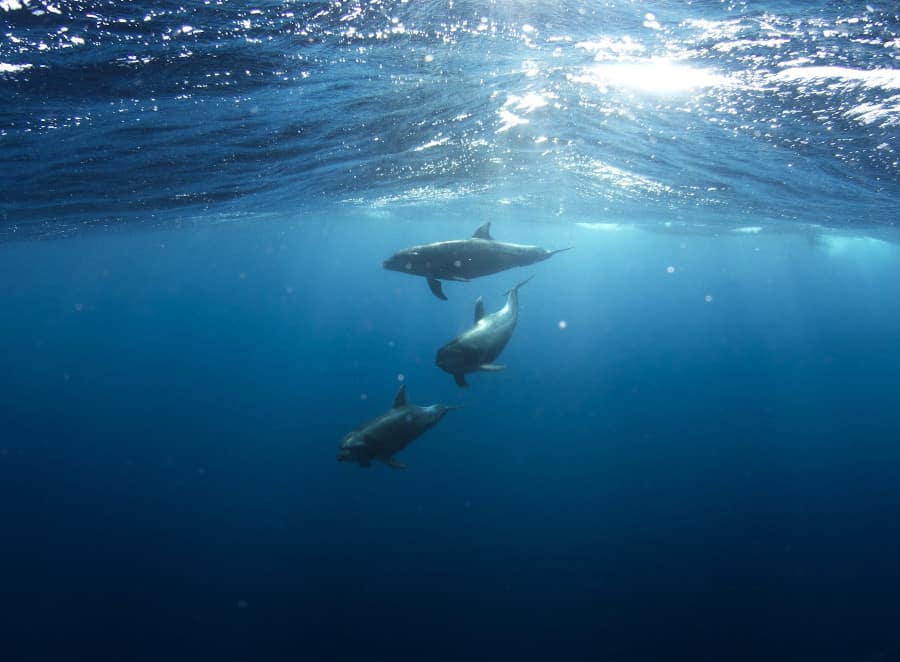My Swim with Wild Dolphins
Our catamaran was headed back to the main island. No longer expecting adventure, passengers were now passively waiting, snacking on tropical fruits, casually scrolling through their photos of the day, and even falling asleep. The aquamarine ocean view no longer captivated them, like it had just hours earlier before we snorkeled. Drunk on ocean water, papaya, and equatorial sun, we were ready to head back to land. Then, the crew shouted something that woke us all back up.
“Dolphins ahead!” I sprinted to the bow of the boat to catch a glimpse. Their fins barely broke the surface, making the majestic creatures appear as tiny blips in the ocean. Our boat slowly closed in on the dolphins, but they didn’t swim away. Now we could see them circling below.
“Anyone want to swim?” a crew member asked.
He didn’t have to finish his sentence before I threw my binoculars into a chair and unwrapped my towel. I quickly secured my goggles and jumped in before the dolphins would swim away. I submerged underwater, but saw nothing. I came back up for air. The crew member asked if I could see anything, and I responded no.
I tried again. After a few seconds, I saw the dolphins. I was in water about 15 m deep, approximately the same depth of the dolphin tank at the Niagara Aquarium I would visit as a child. As a young girl, I would stand up against the glass and watch the dolphins circle around the tank right in front of me. Now I felt like I was in the dolphin tank. The dolphins circled around me the same way I had watched them circle in their tank many years ago. It was one of the most magical experiences of my life.

Why I Regret It
Over a decade later, I thought this was an ethical way to swim with wild dolphins. A way where the dolphins were not forced to be there by nets built into the beach and kiss tourists on the cheek, like they are in “swim with the dolphins” adventures in Florida, Hawaii, and other vacation destinations.
My dolphins could swim away if they wanted to and were by no means captive. But I realized I, a wildlife biologist with a Ph.D., could be wrong.
I posted about this experience on Facebook, only to have my marine biologist friend of mine point out that jumping in the water with marine mammals is never a good idea. It could stress them out, and if there are mother dolphins with calves, separate them.
A few months later, a summary of a recent study popped up on my weekly Science email newsletter. Swimming with wild spinner dolphins in the Middle East was possibly contributing to their declines. This species of dolphin hunts at night and therefore sleeps during the day. Tourists that try to swim with them are disrupting their sleep. Imagine if someone jumped in your bed in the middle of the night!

Researchers found that in an area with higher levels of tourism in Egypt, the dolphins are doing more aerial displays. This is a sign they are NOT happy, which ironically leads to better tourist experiences because people love watching dolphins leap into the air. A study in Hawaii showed these dolphins have been in decline since the 90s, but we don’t know if tourism is the cause. The good news is that once tourists found out that they were disturbing the dolphins, some expressed remorse. While regulations are needed, it’s important to spread these messages because if people don’t pay for it, it will stop. I would be happy to sacrifice the magical dolphin encounter I wrote about above to prevent damage to wildlife populations, especially for a species in decline.

Should You Never Swim with Wild Dolphins?
To complicate the story even more, there can be instances where it is okay to swim with some species of wild dolphins. I submitted this piece for my “Science Writing for the Public” class, and she happened to review it. She told me that some species are very curious and will even come up to tourists in the water.
What’s a girl to do? How do you then know when it’s okay and not okay to swim with wild dolphins? Here’s my advice: If you are going to an attraction that specifically advertises swimming with wild dolphins, be wary and do your research. What species will you have encounters with? Google those species and see if there are negative impacts that ecotourism has on them, as in the case with the spinner dolphin. If you are not sure, contact or tweet me and I will find out from a marine biologist.

If you are on an adventure not specific to dolphins, such as snorkeling or scuba diving, I would adhere to my marine biologist friend’s recommendation and not jump in the water if you see dolphins. As she mentioned, this could stress them out, separate mothers from calves, and disrupt natural behaviors. This advice aligns well with the rules of the Marine Mammal Protection Act set by the United, which prohibits the “taking” of marine mammals. Take is defined not only as hunting and killing, but the harassment of marine mammals. Harassment includes pursuing, tormenting, and/or chasing and is basically any act that can disrupt the animals’ natural behaviors. I would add jumping into the water to this list.
The only way to swim with wild dolphins ethically, is to let them be in charge. If you are in the water for a snorkeling or scuba diving adventure and a dolphin comes to you, consider yourself lucky and enjoy this magical experience!
Unsure if your wildlife tourism adventure is ethical? Read my 5 Guidelines for Ethical Wildlife Tourism to help you evaluate.
SaveSave
SaveSave
Love this post? Share it with friends!



